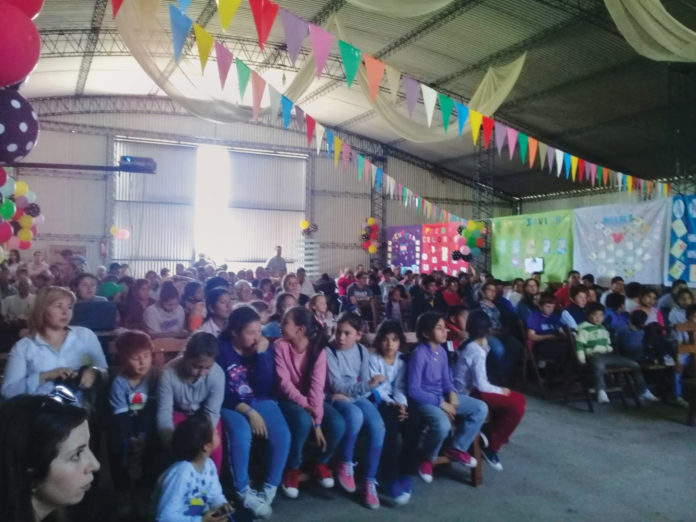

The Mennonite Brethren church in Uruguay is growing in a big way, and its transformation is an expression of increasing cooperation between Mennonite Brethren in Latin America.
Consejo de las Congregaciones de los Hermanos Menonitas en Uruguay (Council of the Congregations of Mennonite Brethren in Uruguay, or CCHMU) is a small conference counting only 184 members in seven congregations. But it will more than quadruple after it merges with an influx of charismatic church plants in a region where CCHMU has never made inroads.
Roughly five years ago, a mission worker associated with Assembly of God churches in the United States became connected with CCHMU. Basilio Schur was passionate but couldn’t receive North American funding because his young churches were located in small towns. The Assemblies of God required him to work in communities of 5,000 people or more.


“They had planted 12 churches and were looking for a place to make one central church for these groups,” says Emerson Cardoso, president of the Brazilian Convention of Evangelical Mennonite Brethren Churches. Also known as COBIM, the much larger Convenção Brasileira das Igrejas Evangélicas Irmãos Menonitas is walking alongside CCHMU to share its experience in partnering with Pentecostal groups.
Cardoso says Uruguayan Mennonite Brethren loaned the group an unused building from a church that had closed. After a few years, the new churches grew to about 700 people in 17 churches in the departments of Rio Negro and Paysandú in northern Uruguay. Some meet in homes; one congregation gathers in a farmer’s machine shed.
“They felt they needed to be part of a family of churches, so who did he ask if he could be part of a family?” Cardoso recalls. “He did not go to his own denomination because they said ‘we can’t support the work you do.’ He went to these MBs who loaned him this place.”
Cardoso says a similar situation happened in Brazil some years ago, and he encouraged his Uruguayan brethren to similarly welcome a different kind of group.
“They are quite charismatic, but they need some theological training, and the Mennonite Brethre have a theological center — a structured organization — but they were not really growing in new places,” Cardoso says. “So now these two groups coming together are learning from each other.”
It hasn’t been easy. Meetings facilitated by COBIM took place over six months.
In the beginning, about 80 percent of Mennonite Brethren felt uncomfortable with the new churches.
“After meeting a few times and drinking a lot of mate together, the thing just tipped over so that about 20 percent are not so comfortable,” Cardoso says. “I would guess that today it is 10 percent who are not so comfortable.”
Building vision, identity
Four years ago, the leader of an international network of MB conferences challenged COBIM to plant new churches in the northern parts of Brazil.
COBIM is much larger than other MB groups in Latin America. It has more than 10,000 members and works at church planting and pastoral training in 12 countries.
David Wiebe, the former secretary of the International Community of Mennonite Brethren, challenged COBIM to help neighboring MB conferences.
Cardoso — who just became chair of ICOMB — says CCHMU was struggling with training for teachers and leaders, in addition to a need for vision. North American mission agencies had supported the conference but withdrew workers and support.
“The first two years we worked on identity, and in the third year they developed a school forming leaders,” he says.
They developed a vision for being a family of churches that could be truly independent right when Schur, the missionary, approached them about borrowing a church building.
“When he made that first meeting in the borrowed church, God spoke to his heart,” Cardoso says. “He felt God was telling him, ‘You need to keep alive the testimony of the Mennonite Brethren because the church was closed.’ ”
The charismatic churches have participated together with Uruguayan Mennonite Brethren on training initiatives based on Anabaptist principles, with an emphasis on reconciliation.
CCHMU President Álvaro Nalerio says the new relationship represented a huge challenge and great opportunity for the conference. The northern communities have no established church, and some people don’t even know what a Bible is.
“This pushes us to move,” he says. “To leave the comfort that religiosity provides and go and preach the gospel in a space that today is seen as ‘the last of the Earth’ even for Uruguayans. . . .
“We learned that love for souls is not learned in books. There are places in Uruguay where the gospel of Christ has not arrived yet, and we can go. We have learned a different way to do things.”
Schur and his wife, Carmen, continue to work with the young network of churches, but they are in their late 60s and work two days a week with beekeeping and a small farm to support their church work the other five days.
“He’s asking for coworkers because his strength is getting low and he wants people to help him visit disciples,” Cardoso says. “In Brazil we were really encouraged to send a worker, but we wanted to let the Uruguayan conference get one. . . .
“On [Sept. 25] they had a meeting and decided CCHMU president Álvaro Nalerio and his wife, Gabriela Alcaire, should go to the north because that’s the best guy they have. So, for us this is a miracle. He will keep on being the president.”
Regional connections
ICOMB hopes the level of cooperation exhibited by Mennonite Brethren in Uruguay and Brazil can continue in other parts of Latin America. MB leaders from across the region met in July in Paraguay to discuss how other kinds of connections and exchanges could happen.
CCHMU, COBIM and MB Mission signed an agreement July 29 outlining how they will work together in the upcoming Uruguayan merger, strengthening the conference in new areas. It’s a natural connection for Cardoso, who is also Latin America regional team leader for MB Mission.
ICOMB executive director Rudi Plett of Asuncion, Paraguay, says the regional network will work over the next 12 months on opportunities in the areas of missions, education, pastoral care and conference building. Financial resources will be shared least.
“The whole idea is to connect these conferences,” he says. “. . . We came together to share and ask how we can work together in addition to this connection that happened.”
This article is reprinted with permission from Mennonite World Review.


Tim Huber is associate editor of Anabaptist World, an independent journalistic ministry serving the global Anabaptist movement. He worked at Mennonite World Review, an independent newspaper, from 2011 until 2020 when MWR merged with The Mennonite, a 135-year-old denominational magazine, to form Anabaptist World. A graduate of Tabor College, he and his wife, Heidi, served with Mennonite Central Committee in Germany, where the first of their three children were born. His family attends Shalom Mennonite Church in Newton, Kansas.






















